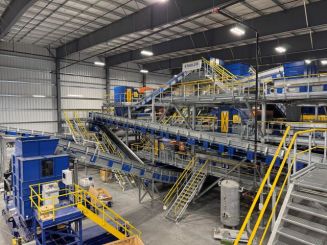The metal recovery with Tomra Sorting Recycling
Interview to Frank van de Winkel, metal division manager in Tomra Sorting Recycling.

Recycling Industry: Can you tell us which is the situation in Italy in the metal recycling industry? Metals have been recycled for longer than plastic.
Frank van de Winkel: True, for metals, it is a different business case, tipically metals got recycled because they are more valuable and by recycling you could save energy and then they could be remelted and recycled into the same quality. In Europe, for metal recycling Tomra Sorting has different areas of business: automotive recycling, e-scrap recycling, smelters and then household waste incenerators. In all those business segments we try to recover the valuable metals before they get lost. It is not a question if we can recycle but if we can find the metals to recycle. In automotive industy, there is a legislation, the End of life vehicle directive that commands to recover materials from a car. The car goes into a recycling process because the law enforces it. In the smelting business, like aluminum, there is limited legislation but it’s about recovering the max value.
Today we need to make sure that we recycle at the highest quality possible. Let us take the Aluminum example, in a waste dump in 15 years will be oxidized and gone. For us it is important that from the current waste streams we recover the maximum quantity of metals that we can recover and sort them at the highest quality possible. Especially aluminum from car manufacturers (sheet aluminum alloy). If you mix it with another aluminum (wheel, cast aluminum) you start downcycling, that is to say degrading the quality of aluminum. That is why Tomra’s technology is going to higher quality, higher sorting, not only aluminum, but also taking diferent alloys of alluminum and also separating them so that the quality for recycling is better and you can make higher quality products out of it. This is the future. As business development manager, I see more trends going into alloy recycling and monofraction material.
Recycling Industry: Can you tell us something about Tomra machines to sort aluminum and metals?
Frank van de Winkel: We start recovering metals with our technology called Tomra finder. Think of a car getting shredded, we take out aluminum with eddy current and steel with a magnet and we have some left overs. The metallic left overs are stainless steel, copper wire, and printed circuit boards etc. So now we use this tool to recover from the mix of those metals, those remaining metals in order to make them available for recycling. otherwise they are lost
Then the next machines, like Combisense (colour sorting machine) and the X tract machine (sort by density) this is about upgrading recovered material/metals into higher quality. After eddy current (corrente di Foucalt) you have two fractions (the metallic fraction that flies and a fraction that drops). The fraction that drops goes to this machine to recover the residual metals: stainless steel and copper wire. The fraction that gets thrown will go to this machine that separates by density. So you will separate copper brass zinc from aluminum and lighter metals.
After this machine we have on one side heavy metals and on one side light metals. So you could go to a colour sorting machine, Combisense (as heavy metals are copper brass zinc, red, yellow, grey) and we can sort by colour in order to get clean, recyclable copper, brass, etc fractions.
The X tract can also do something more: if you have different grades of sheet aluminum, like taint table (only sheet material but dirty) with different aluminum alloy groups (pure aluminun, but also aluminum alloy with zinc (7000), aluminum alloy with copper (2000) and to get copper and zinc out to sort it by density.
And in the future we will have a machine to sort all aluminum into different alloy groups (LIBS machine).
Recycling Industry: Is there a margin for growth in Italy for the metal recycling industry?
Frank van de Winkel: We definitely see chances in Italy for the smelters business (that is why we are at this show), finding people that today use more primary aluminum that can replace it with secondary aluminum to be sorted and pay less. We are loooking into the growth potential of the smelters segment in Italy.












